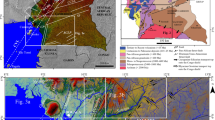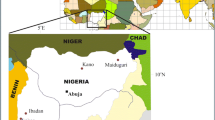Abstract
The stabilization of side-slopes in the small valleys of two major loess regions, the American Midwest and E Transdanubia in Hungary, were studied based upon the field measurements of 224 relatively stabilized slope profiles; for comparison, 97 profiles were also measured in non-loessic areas near the American loess region. Data from the field measurements were then subjected to frequency distribution analyses according to various groupings and the mean values were compared in terms of slope declivity and angularity.
The effect of lithology on slope development is demonstrated by the finding that the valley side-slopes in loess are steeper by 6° and more angular by about 7° than those in non-loess. Also, the valleys in loess tend to be more symmetrical than those in non-loess. A comparison of the upper and lower sections of the valleys that were subjected to a double-cycle of erosion into the same sediment within the same region, i.e., into loess in the American Midwest, indicate the effect of time. The lower, which are also younger, sections of these valleys are steeper by 10° and more angular by 9° than their upper ones; thus the model of reclining slope retreat seems to be confirmed here. A moderate effect of exposure on slope development is indicated by the slightly steeper and more angular (by 1° – 2°) slopes exposed to the N-NE-E versus those exposed to the S-SW-W.
Because of the complex and interrelated dynamic processes involved in slope evolution there are probably many factors which are responsible for the stabilization of the valley side-slopes of the study areas; some explanations are offered in this paper. It was also found that differences in lithology, time and exposure influence primarily the youngest, which are also the relatively least stable, components of the slope.
Similar content being viewed by others
References
Ádám, L.: A Tolnai Dombság kialakulása és felszinalaktana (Evolution and surface forms of the hill region near Tolna, Hungary). Földrajzi Tanulmánvok 10, Budapest: Akadémiai Kiado, 1986 p. (1969)
Bariss, N.: A comparative landform study of selected loess areas in the Missouri River Basin. In: Schultz, C.B.; Frye, J.C. (eds.), Loess and Related Eolian Deposits of the World, 81–99. University of Nebraska Press, Lincoln, 1968.
Bariss,, N.: Gully formation in the loesses of Central Nebráska. Rocky Mountain Social Science Journal 8,2, 47–59 (1971)
Bariss, N.: Effects of lithology and time on slope characteristics. In: Adams, W.P.; Helleiner, F.M. (eds.), International Geography, Vol. 1, 100–104. University of Toronto Press, 1972.
Bariss, N.; Bronger, A.: Natürliche und anthropogene Owragibildung in verschiedenen Klimazonen (Natural and man-initiated owrag formation in different climatic zones). Zeitschrift für Geomorphologie, N.F. 25, 2, 180–202 (1981)
Brice, J.C.: Erosion and deposition in the loess-mantled Great Plains, Medicine Creek Drainage Basin, Nebraska. US Geological Survey. Professional Paper 352-H, 255–339 (1966)
Carson, M.A.; Kirkby, M.J.: Hillslope, Form and Process, 475 p. Cambridge University Press, London, 1972.
Lohnes, R.A.; Handy, R.L.: Slope angles in friable loess. Journal of Geology 76, 247–258 (1968)
Pécsi, M.: Ten Years of Physico-Geographic Research in Hungary, 132 p. Akadémiai Kiadó, Budapest 1964.
Pécsi, M.: Relationship between slope geomorphology and Quaternary slope sedimentation. Acta Geol. Acad. Scientiarum Hungaricae 11, 1–3, 307–321 (1967)
Pécsi, M. (ed.): Magyarország Geomorfológiai Térképe (The Geomorphological Map of Hungary). Kartográfiai Vállalat, Budapest, 1972.
Small, R.J.: The Study of Landforms, 486 p. Cambridge University Press, London 1970.
Strahler, A.N.: Quantitative analysis of watershed geomorphology. Trans. Am. Geophysical Union 38, 6, 913–920 (1957)
Thorp, J.; Smith, H.T.U.: Pleistocene Eolian Deposits of the United States, Alaska and Parts of Canada (map). Geological Society of America, New York, 1952.
Wood, A.: The development of hillslopes. Proceedings of the Geologists' Association 53, 128–140 (1942)
Young, A.: Slope profile analysis. Zeitschrift für Geomorphologie, Suppl. 5, 17–27 (1964)
Author information
Authors and Affiliations
Additional information
Most of the results of this research were presented at the XI INQUA Congress in Moscow, USSR, 1982.
Rights and permissions
About this article
Cite this article
Bariss, M. Effects of lithology, time and exposure on the stabilization of loess matled slopes. A comparative study. GeoJournal 15, 167–172 (1987). https://doi.org/10.1007/BF00157943
Issue Date:
DOI: https://doi.org/10.1007/BF00157943




